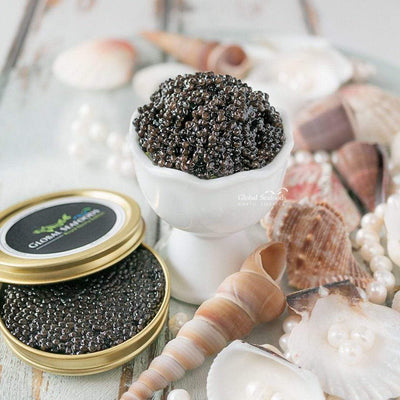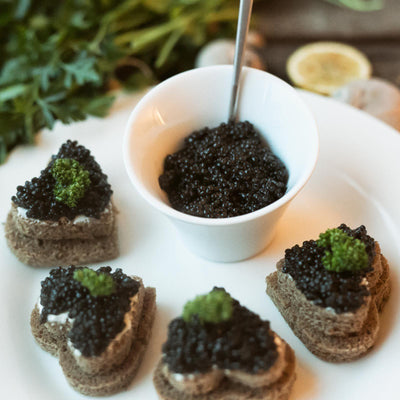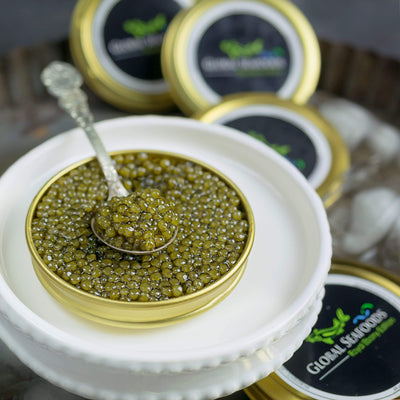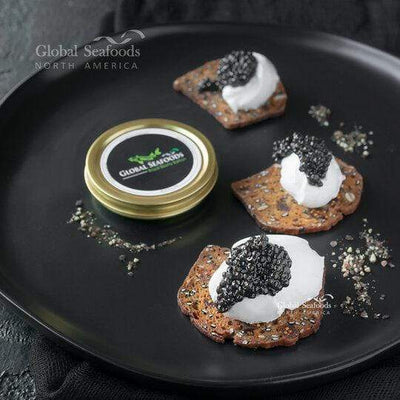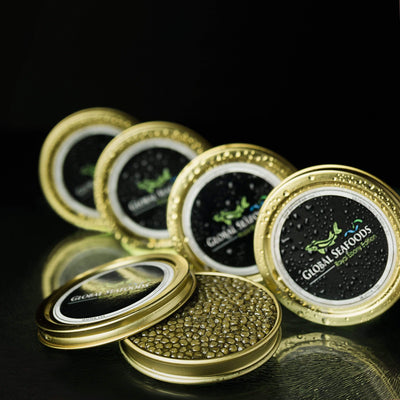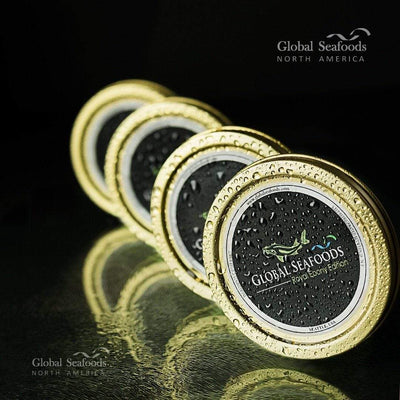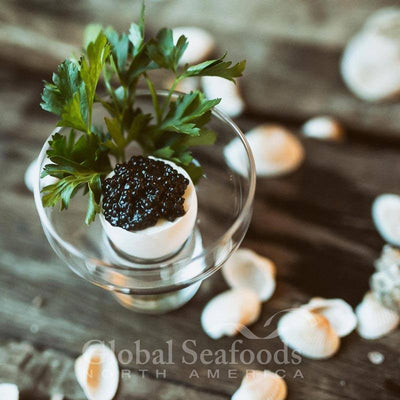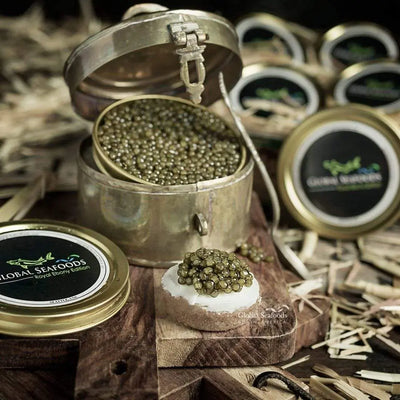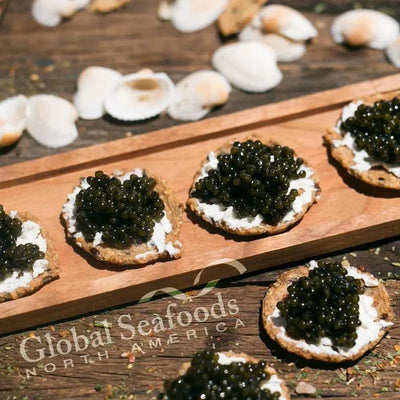Black Caviar Closeup: Origins, Varieties, and Serving Tips

Black Caviar Serving Tips
Black caviar, a symbol of gastronomic luxury, is harvested from the sturgeon, a species renowned for producing some of the world's most exquisite caviar. This guide will navigate through the intricacies of black caviar, including its origins, the best varieties, and how to serve this prized delicacy, ensuring connoisseurs can fully appreciate its rich history and culinary prestige.
Introduction to Black Caviar
Black caviar, the roe of sturgeon fish, is celebrated for its unique flavor and texture. Often associated with Russian culinary traditions, black caviar encompasses several species of sturgeon, with Beluga, Osetra, and Sevruga varieties being the most coveted. This delicacy's allure lies not just in its taste but also in its nutritional benefits, making it a sought-after ingredient in haute cuisine.
The Prestigious Varieties of Black Caviar
Beluga Black Caviar
Known for its large, silky eggs, Beluga caviar is the epitome of luxury. Its delicate, buttery flavor sets the standard for black caviar.
Osetra Black Caviar
With a slightly nutty taste and medium-sized grains, Osetra caviar offers a rich depth of flavor that appeals to many enthusiasts. Discover more about Osetra Sturgeon Caviar Royal Crown and Russian Ossetra Sturgeon Caviar.
Sevruga Black Caviar
Prized for its intense, savory taste, Sevruga features smaller, more concentrated pearls.
Kaluga Black Caviar
A sustainable alternative to Beluga, Kaluga caviar is celebrated for its similar size and buttery texture, making it a favorite among connoisseurs. Learn more about Kaluga Caviar.
Culinary Uses and Serving Suggestions
Black caviar can transform any dish into a luxurious experience. Traditionally served on blinis with a dollop of crème fraîche, it can also enhance the flavors of simple ingredients like eggs or potatoes. To preserve its delicate taste, it's recommended to use non-metallic utensils, such as mother-of-pearl spoons, when serving.
Nutritional Profile of Black Caviar
Aside from its luxurious appeal, black caviar offers significant health benefits. It's a rich source of omega-3 fatty acids, essential for cardiovascular health and cognitive function, and is also high in vitamins A, E, and B12, alongside minerals like selenium and magnesium.
Sustainability in Black Caviar Production
The sustainability of black caviar production has become a critical issue due to the overfishing of wild sturgeon. However, the rise of aquaculture has led to more ethical and sustainable practices in caviar harvesting, with farms in the USA and globally producing high-quality, sustainable black caviar.
Choosing the Best Black Caviar
When selecting black caviar, consider the source and the sustainability of the production practices. American black caviar and Russian black caviar are both highly regarded, but the best choice will depend on personal taste preferences and the commitment of the producer to sustainable practices. Explore high-quality options like Russian Osetra Caviar and Paddlefish Caviar.
Conclusion
Black caviar remains a timeless delicacy, revered for its exquisite taste, rich nutritional benefits, and the luxurious experience it provides. Whether opting for Beluga, Osetra, Sevruga, or Kaluga caviar, enthusiasts can enjoy the unparalleled quality of black caviar while also supporting sustainable and ethical harvesting practices. Knowing how to serve and appreciate this gourmet treasure allows for a deeper understanding and enjoyment of one of the world's most esteemed culinary delights.
Frequently Asked Questions about Black Caviar
What is black caviar? Black caviar is the roe or eggs of sturgeon fish, primarily harvested for its luxurious taste and texture. It is considered one of the most exquisite delicacies in the world, known for its rich, buttery flavor.
Why is black caviar so expensive? Black caviar's high price is due to the rarity of sturgeon, the extensive time required for sturgeon to mature and produce eggs, and the meticulous process involved in harvesting, processing, and preserving the caviar.
What are the main types of black caviar? The main types of black caviar are Beluga, Osetra, and Sevruga. Each type comes from a different species of sturgeon and varies in size, color, texture, and flavor.
How can I tell if black caviar is of good quality? High-quality black caviar has a fresh, clean sea smell, firm eggs that separate easily, and a glossy appearance. The flavor should be rich and buttery, without any fishy or overly salty taste.
How should black caviar be served? Black caviar is best served chilled on a non-metallic spoon, such as mother-of-pearl or glass, to avoid altering its flavor. It can be enjoyed on its own or with simple accompaniments like blinis, toast points, or unsalted crackers and crème fraîche.
Can black caviar be part of a healthy diet? Yes, black caviar is rich in omega-3 fatty acids, vitamins A, E, B12, and minerals like selenium and magnesium, making it a nutritious addition to a balanced diet when consumed in moderation.
Is there a sustainable way to consume black caviar? Sustainable consumption of black caviar involves purchasing caviar from farms that use responsible aquaculture practices to raise sturgeon, thereby reducing the impact on wild sturgeon populations and ensuring the long-term viability of caviar production.
What is the difference between Russian and American black caviar? Russian black caviar traditionally refers to caviar harvested from wild sturgeon in the Caspian Sea, known for its exceptional quality. American black caviar usually comes from sturgeon farmed in the United States under controlled conditions, offering a sustainable alternative with high-quality standards.
How long can black caviar be stored? Unopened black caviar can be stored in the coldest part of the refrigerator for up to a few weeks, depending on the packaging and preservation method. Once opened, it should be consumed within 1-3 days for the best quality.
Can black caviar be frozen? Freezing black caviar is not recommended as it can alter the texture and flavor of the eggs. It's best to purchase caviar in quantities that can be consumed shortly after opening to enjoy its optimal taste and quality.
Explore More:
- Compare different varieties with Beluga Caviar and Osetra Sturgeon Caviar.
- Experience sustainable options like Wild Sturgeon Black Caviar and other premium options in the Ossetra Caviar collection.
Also in News

How to Make Sea Bream Sushi With Dry-Aged Tuna & Crab Roll — Step-by-Step With Chef Joshua
A complete guide to making Sea Bream sushi at home, including filleting, curing, slicing, and building a Dry-Aged Tuna & Crab sushi roll. Chef Joshua shares professional tips for restaurant-quality results.

Boiled Crab for Game Night: Everything You Need for a Perfect Seafood Party
Take your game night to the next level with a Boiled crab party. Learn the best recipes, cooking tips, and hosting hacks for a memorable seafood feast.

Boiled Crab for Date Night: A Romantic Guide to the Perfect Seafood Feast
Make your next date night unforgettable with a romantic Boiled crab experience. This guide covers everything you need to know, from ambiance to the best crab varieties.

